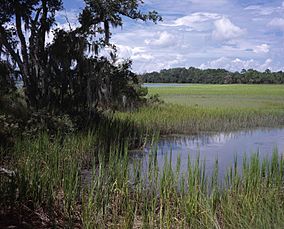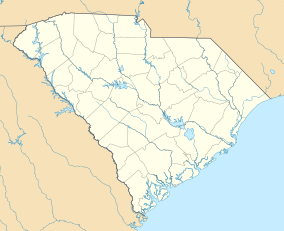Pinckney Island National Wildlife Refuge facts for kids
Quick facts for kids Pinckney Island National Wildlife Refuge |
|
|---|---|
|
IUCN Category IV (Habitat/Species Management Area)
|
|

Pinckney Island National Wildlife Refuge
|
|
| Location | Beaufort County, South Carolina, United States |
| Nearest city | Hilton Head Island, South Carolina |
| Area | 4,053 acres (16.40 km2) |
| Established | 1975 |
| Visitors | 400,000 (in 2004) |
| Governing body | U.S. Fish and Wildlife Service |
| Website | Pinckney Island National Wildlife Refuge |
The Pinckney Island National Wildlife Refuge is a special natural area covering about 4,053 acres (16.4 km2) in Beaufort County, South Carolina. It's located between the mainland and Hilton Head Island. This refuge is named after a famous American, Major General Charles Cotesworth Pinckney. It was created to protect nature and forests, keeping them beautiful and safe for wildlife.
This refuge is one of seven managed by the Savannah Coastal Refuges Complex in Savannah, Georgia. These refuges work together to protect important coastal habitats.
Contents
A Look Back in Time: The History of Pinckney Island
Pinckney Island has a long and interesting history. Experts have found 115 ancient sites here. These sites show that people lived on the island as far back as 8,000 BC. They used the island a lot between 1000 AD and 1500 AD.
Early Settlements and Owners
In the 1500s and 1600s, French and Spanish groups briefly settled on Pinckney Island. But people didn't live there permanently until 1708. That's when Alexander Mackay, a trader, bought part of the island. By 1715, he owned most of the islands that make up the refuge today.
In 1736, Mackay's wife sold the islands to Charles Pinckney. He was the father of General Charles Cotesworth Pinckney.
General Pinckney and the Plantation Era
General Pinckney was an important figure in American history. He was a commander during the American Revolutionary War. He also helped sign the Constitution of the United States, which is the main rulebook for the U.S. government.
General Pinckney inherited the islands from his father. In 1804, he moved to the island and started managing it as a large farm, called a plantation. They cleared much of the forest and grew crops like fine Sea Island Cotton. By 1818, many people lived and worked on the island.
The Civil War and Beyond
The plantation thrived until the American Civil War. During the war, soldiers from the Union Army occupied the island. There were small fights on Pinckney Island. One notable event happened on August 21, 1862. Soldiers from the Confederate Army attacked a Union camp.
After the war, the plantation struggled. By the 1930s, it was mostly empty. In 1937, the Pinckney family sold the islands after owning them for over 200 years. Ellen Bruce and her husband, James Bruce, bought the property. They used it as a place for hunting. They planted trees and built ponds to attract waterfowl.
In 1954, Edward Starr and James Madison Barker bought the islands. They also managed it as a game preserve. Then, in 1975, they gave the islands to the United States Fish and Wildlife Service. This gift meant the islands would be protected forever. On December 4, 1975, Pinckney Island became a National Wildlife Refuge. It is now managed as a nature and forest preserve for everyone to enjoy.
Exploring the Landscape: Topography of the Refuge
The Pinckney Island National Wildlife Refuge covers 4,053 acres (16.4 km2). It includes several islands: Pinckney Island, Corn Island, Big Harry and Little Harry Islands, and Buzzard Island. There are also many smaller islands called hammocks.
Pinckney Island is the largest island and the only one open to visitors. About 67% of the refuge is made up of salt marsh and tidal creeks. Pinckney Island itself has many different types of land. You can find saltmarsh, forests, brushland, old farm fields, and freshwater ponds. All these different areas create homes for many kinds of birds and plants.
Amazing Wildlife: Animals of Pinckney Island
Pinckney Island is a great place to see wildlife. You might spot many kinds of birds, including:
- Waterfowl (like ducks and geese)
- Shorebirds
- Wading birds (like white ibis, herons, and egrets)
- Raptors (birds of prey)
- Migratory birds that travel long distances
You can also see white-tailed deer here. Other interesting animals include the American alligator, nine-banded armadillo, bald eagle, and the wood stork.
Visitor Information: Facilities and Activities
There isn't a visitor center at the refuge. However, there are many fun things to do! You can enjoy:
- Hiking
- Cycling
- Photography
- Wildlife observation
To keep the deer population healthy, the refuge holds a special one-day deer hunt each year. This helps make sure there are enough resources for all the animals. Fishing is not allowed from the land parts of the refuge.
Trails for Adventure
There are about 10 miles (16 km) of hiking trails on the refuge. Here are nine popular hikes you can take:
- Ibis Pond - 1.2 miles (1.9 km) round trip; about 1.5 hours walking
- Shell Point - 4.6 miles (7.4 km) round trip; about 4 hours and 15 minutes
- Wood Stork Pond - 2.7 miles (4.3 km) round trip; about 2.5 hours
- Osprey Pond - 3.0 miles (4.8 km) round trip; about 3 hours
- Nini Chapin Pond - 3.6 miles (5.8 km) round trip; about 3.5 hours
- Bull Point - 5.0 miles (8.0 km) round trip; about 5 hours
- Dick Point - 7.4 miles (11.9 km) round trip; about 6.5 hours
- Clubhouse Pond - 6.2 miles (10.0 km) round trip; about 5.5 hours
- White Point - 7.8 miles (12.6 km) round trip; about 7 hours


